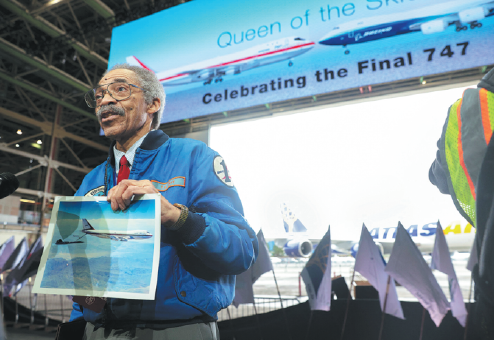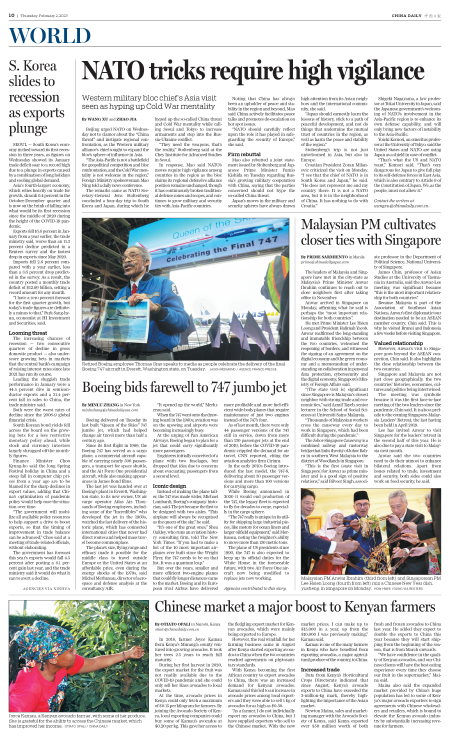
Retired Boeing employee Thomas Gray speaks to media as people celebrate the delivery of the final Boeing 747 aircraft in Everett, Washington state, on Tuesday.
Boeing delivered on Tuesday its last built "Queen of the Skies" 747 jumbo jet, which had helped change air travel more than half a century ago.
Since its first flight in 1969, the Boeing 747 has served as a cargo plane, a commercial aircraft capable of carrying nearly 500 passengers, a transport for space shuttle, and the Air Force One presidential aircraft, while also making appearances in James Bond films.
The last jet was handed over at Boeing's plant in Everett, Washington state, to its new owner, US air cargo operator Atlas Air. Thousands of Boeing employees, including some of the "Incredibles" who developed the jet in the 1960s, watched the last delivery of the historic plane, which has connected international cities that never had direct routes and helped mass travel become commonplace.
The plane's size, flying range and efficacy made it possible for the middle class to travel outside Europe or the United States at an affordable price, even during the energy shocks of the 1970s, said Michel Merluzeau, director of aerospace and defense analysis at the consultancy AIR.
"It opened up the world," Merluzeau said.
When the 747 went onto the drawing board in the 1960s, aviation was on the upswing and airports were becoming increasingly busy.
At the urging of Pan American Airways, Boeing began to plan for a jet that could carry significantly more passengers.
Engineers initially conceived of a plane with two fuselages, but dropped that idea due to concerns about evacuating passengers from a second level.
Iconic design
Instead of making the plane taller, the 747 was made wider, Michael Lombardi, Boeing's company historian, said. The jet became the first to be designed with two aisles. "This airplane will always be recognized as the queen of the sky," he said.
"It's one of the great ones," Shea Oakley, who runs an aviation history consulting firm, told The New York Times. "If you had to make a list of the 10 most important airplanes ever built since the Wright Flyer, the 747 needs to be on that list. It was a quantum leap."
But over the years, smaller and more efficient two-engine planes that could fly longer distances came to the market. Boeing and its European rival Airbus have delivered more profitable and more fuel-efficient wide-body planes that require maintenance of just two engines instead of the 747's four.
As of last month, there were only 44 passenger versions of the 747 still in service, down from more than 130 passenger jets at the end of 2019, before the COVID-19 pandemic crippled the demand for air travel, CNN reported, citing the aviation analytics firm Cirium.
In the early 2010s Boeing introduced the last model, the 747-8, delivering about 50 passenger versions and more than 100 versions for carrying cargo.
While Boeing announced in 2020 it would end production of the 747, the legacy fleet is expected to fly for decades to come, especially in the cargo sphere.
"The 747 really is unique in its utility for shipping large industrial pieces, like motors for ocean liners and larger oilfield equipment," said Merluzeau, noting the freighter's ability to move more than 130 metric tons.
The plane of US presidents since 1990, the 747 is also expected to keep up its official duties for the White House in the foreseeable future, with two Air Force One aircraft now being modified to replace jets now working.
Agencies contributed to this story.
minluzhang@chinadailyusa.com

